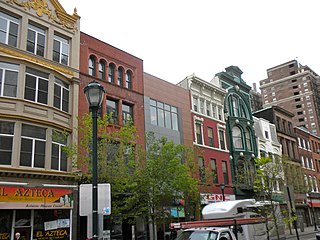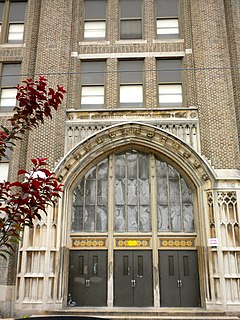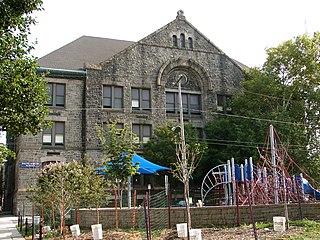
Northern Liberties is a neighborhood in Philadelphia, Pennsylvania, United States. Prior to its incorporation into Philadelphia in 1854, it was among the top 10 largest cities in the U.S. in every census from 1790 to 1850.

Callowhill is one of the unofficial names for a neighborhood in Philadelphia, Pennsylvania located roughly in the vicinity of Callowhill Street, between Vine Street, Spring Garden Street, Broad Street, and 8th Street. The name "Callowhill" was coined by the Callowhill Neighborhood Association, a community organization in the area; although this name often appears on online maps, the City of Philadelphia does not have an official name for this area. Callowhill is named for Callowhill Street, which was named after Hannah Callowhill Penn, William Penn's second wife. Callowhill was formerly home to large-scale manufacturing and other industries, of which an architectural history has been left in the form of grand old abandoned factories. During the 1970s and 1980s, the population of Callowhill plummeted, and although numbers are rising, it is a fairly unpopulated section of the city compared to surrounding neighborhoods. Recently developers have started to employ adaptive reuse projects, converting them into loft style housing; so much so that many have termed the neighborhood "The Loft District". In 2010 the Callowhill Industrial Historic District was added to the National Register of Historic Places.

The Fisher Fine Arts Library was the primary library of the University of Pennsylvania from 1891 to 1962. The red sandstone, brick-and-terra-cotta Venetian Gothic giant—part fortress and part cathedral—was designed by the acclaimed Philadelphia architect Frank Furness (1839–1912). The cornerstone was laid in October 1888, construction was completed in late 1890, and the building was dedicated in February 1891.

The Packard Motor Car Company Building, also known as the Press Building, is a historic office building located at 317–321 N. Broad Street between Pearl and Wood Streets in the Callowhill neighborhood of Philadelphia, Pennsylvania. The structure was built in 1910–11 and was designed by Albert Kahn of the noted Detroit architectural firm of Kahn & Wilby. It is a seven-story, steel framed, reinforced concrete building – one of the first uses of that material in a commercial building. Clad in terra cotta and featuring an ornamented canopy and a prominent overhanging roof, the building housed a showroom and new car inventory space for the Packard Motor Car Company. The showroom was remodeled in 1927 by Philip Tyre. In November 1928, the building became the headquarters of the Philadelphia Record newspaper, which it remained until the Record folded in a 1947 strike.

The East Center City Commercial Historic District is a national historic district located in the Washington Square neighborhood of Philadelphia, Pennsylvania. It encompasses 287 contributing structures, including large and small commercial buildings, banks, hotels, newspapers, clubs, and restaurants.

Parkway Center City Middle College is a historic vocational school located in the Callowhill neighborhood of Philadelphia, Pennsylvania. It is part of the School District of Philadelphia. The building was built in 1925–1927 and is a brick building in the Academic Gothic-style.

Bache-Martin Elementary School is a preK–8 school located in the Fairmount neighborhood of Philadelphia, Pennsylvania. It is part of the School District of Philadelphia. The school campus comprises two distinct buildings along 22nd Street, both of which were listed on the National Register of Historic Places in 1986.

Genergal George G. Meade School is a historic elementary/middle school located in the North Central neighborhood of Philadelphia, Pennsylvania. It is part of the School District of Philadelphia. The building was designed by Irwin T. Catharine and built in 1936. It is a three-story, 11 bay, yellow brick building in a Moderne-style. It has a four-story, five bay addition. It features rounded corners, ribbon bands of windows, and low relief Greek figures. It was named for General George Meade (1815–1872).

William Rowen Elementary School is a historic elementary school located in the West Oak Lane neighborhood of Philadelphia, Pennsylvania. It is a part of the School District of Philadelphia.

Joseph C. Ferguson School is a historic school building located in the Cecil B. Moore neighborhood of Philadelphia, Pennsylvania. It was designed by Irwin T. Catharine and built in 1921–1922. It is a three-story, nine bay, U-shaped brick building on a raised basement, in the Colonial Revival-style. It features large stone arches, a double stone cornice, and brick parapet.

Goodman Brothers and Hinlein Company is a historic factory building located at 1238 Callowhill Street in the Callowhill neighborhood of Philadelphia, Pennsylvania. It was built in 1909, and is an eight-story, nine bay reinforced concrete building with brick facing. It has housed a dress trimmings company, lithographic printing company, and a warehouse.

The General Electric Switchgear Plant is a historic factory building located at 421 North 7th Street at Willow Street in the Callowhill neighborhood of Philadelphia, Pennsylvania. It was built in 1916, and is a seven-story, seven bay by nine bay, reinforced concrete building with brick facing. It was designed by William Steele & Company for General Electric, which manufactured electric switchboard equipment there.

Philadelphia Wholesale Drug Company Building is a historic warehouse building located in the Callowhill neighborhood of Philadelphia, Pennsylvania. It was built in 1927, and is a seven-story, seven bay by five bay, reinforced concrete building with brick and cast stone facing. It measures approximately 190 feet by 112 feet. It was built by the Philadelphia Wholesale Drug Company Building, one of the first druggist cooperatives in the United States.

Smaltz Building, also known as the Smaltz-Goodwin Building, is a historic factory building located in the Callowhill neighborhood of Philadelphia, Pennsylvania. It was built in 1911, and is a 10-story, 11 bay by five bay, reinforced concrete building. It originally housed the Smaltz-Goodwin women's shoe manufacturer until 1933, then a variety of clothing manufacturers.

Terminal Commerce Building, also known as the North American Building, is a historic building complex located in the Callowhill neighborhood of Philadelphia, Pennsylvania. It was built between 1929 and 1931 by the Reading Company, and is a combined office, showroom, parking garage, warehouse and freight station totaling over 1.3 million square feet. It measures 528 feet by 225 feet. The front section houses offices, and is a 14-story, reinforced concrete, brick and terra cotta faced building in the Art Deco style. The front facade has a central tower with terra cotta ornamentation that houses water tanks. The rear warehouse section is 12-stories and is "H"-shaped.

Northern Saving Fund and Safe Deposit Company, also known as Provident National Bank, is a historic bank building located in the Callowhill neighborhood of Philadelphia, Pennsylvania. The original section was built in 1872–1873, and is a two-story, light grey granite building. Additions were built in 1888 and 1903.

William S. Peirce School is a historic school building located in the Southwest Center City neighborhood of Philadelphia, Pennsylvania. It was designed by Irwin T. Catharine and built in 1928–1929. It is a four-story, nine bay, brick building on a raised basement in the Late Gothic Revival-style. It features pilasters with limestone caps and a projecting entrance pavilion with an arched opening.

Washington Avenue Historic District, or Washington Avenue Factory District, is a national historic district located in the Hawthorne and Bella Vista neighborhoods of South Philadelphia, Pennsylvania. It comprises the remaining four blocks of one of the last industrial neighborhoods in Philadelphia, and encompasses eight contributing buildings built between 1889 and 1927:
The West Broad Street Commercial Historic District is a national historic district located at Richmond, Virginia. The district encompasses 20 contributing buildings built between about 1900 and the late 1930s. Located in the district is the Forbes Motor Car Company (1919), Harper-Overland Company building (1921), Firestone Building (1929), Engine Company No. 10 Firehouse, and the Saunders Station Post Office (1937). The majority of the buildings are two-to-four stories in height and are composed of brick with stucco, stone and metal detailing. Located in the district is the separately listed The Coliseum-Duplex Envelope Company Building.

The Davenport Motor Row and Industrial Historic District is a nationally recognized historic district located on the eastern edge of downtown Davenport, Iowa, United States. It was listed on the National Register of Historic Places in 2019. At the time of its nomination it consisted of 28 resources, which included 21 contributing buildings, one contributing site, one contributing structure, and five non-contributing buildings. The area was previously a part of the notorious Bucktown, a district of saloons, beer gardens, brothels, billiard parlors, gambling establishments, and theaters. Davenport licensed prostitution in 1893, gambling in 1904, and failed to enforce Iowa prohibition laws during this period. A crusade against vice by Davenport's Catholic bishop, Henry Cosgrove, and reforms by state leaders led to the district's transformation in the early 20th century into a light industrial area. The city's automobile industry settled here beginning in the 1910s. They stayed until the mid-20th century when Interstate 80 was completed on the north side of the city and they moved to the suburban areas. U.S. Route 32 and its successor U.S. Route 6 passed through the district on East Second Street from 1926 to 1937. The Government Bridge (1896), which for years was the city's only bridge across the Mississippi River, is immediately adjacent to the district.































